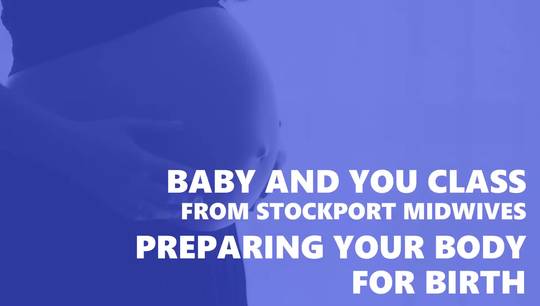Baby and You
Baby and You - Session 1 - Stages of Labour
1,267 views
Stages of labour
I just wanted to talk to you a little bit about the stages of labour which you may have heard of. There’s actually four of them. The first stage of labour we actually split in to two. There’s the latent phase which is the early part of labour, the bit that you probably do at home, and there’s the active phase. The whole first stage is basically the cervix going from a closed cervix to a fully open cervix or neck of the womb. The second stage is the bearing down stage where you give birth to your baby. So, we split it up into latent and active because they can look very different. The latent phase your surges might be quite infrequent, quite irregular, they might be coming every 5 or 10 minutes and then they start to pick up a little in pace. So, we usually say that active labour looks like a woman who is having surges every two to three minutes and for each one to last for around a minute and for them to be in a rhythm or a pattern. If they are still a bit irregular where you might have them every two to three minutes for say 10 or 15 minutes and then you have a really big gap, that suggests to us that you might not be quite in the active stage of labour just yet. If you were to have a vaginal examination, then we would consider active labour to be 5 or 6 centimetres and beyond. Even if you were 5 or 6 centimetres but your surges were still very irregular, we still wouldn’t necessarily say that is active labour. It’s like these two things have to go hand in hand because without regular surges it’s unlikely to make many changes to the neck of the womb and how that opens. So, surges are really important and think about your environment because if surges are irregular it might be to do with the environment or your position that’s affecting how much oxytocin you’re releasing. Oxytocin equals surges. For the active part of labour, you will either be at home and call for a community midwife, or that might be the point where your partner rings the hospital and speaks to someone about bringing you in for the birth. That’s the point where we want you to be quite mobile and active. We want you to be adopting upright positions and think about the position of your baby. We mentioned gravity is really important because the more pressure you can put on the neck of the womb, the more you’ll get that feedback response to your brain to make lots of oxytocin. So, upright positions are really important.
For the second stage of the birth, that’s the bearing down stage, it can last anything from a few minutes to a couple of hours depending on where the baby is in the birth canal and the woman’s urge to bear down. It is about using those muscles and some effort to bear down and push your baby out, but there might be a big chunk of the second stage where you feel that you are bearing down, and we can’t see the baby’s head for quite some time. When we see the baby’s head, we know it’s the latter part of the second stage. You will feel lots of pressure in your rectum before we even see the baby’s head and all of sudden that pressure becomes an overwhelming sensation to suddenly move those muscles and bear down. We’ll guide you with that and we’ll support you during that, but really what you have to do is just listen to your body and do whatever your body is instinctively telling you to do. So, you will give birth to your baby, that’s the second stage and we recommend that you bring your baby straight up on to your chest and skin to skin and we’ll cover skin to skin in more depth in another session. Once your baby is next to you and you are looking at your baby, you will release hormones to help you birth the placenta and the membranes, the bag of water that your baby has been sat in. The birth of the placenta and membranes is actually classed as the third stage. We’ll go in to your options for the third stage in a little more detail on another session. The fourth stage is your skin to skin and holding your baby for the first time and thinking about that first feed with your baby. So that’s the stages of labour. We want you to think about the breathing techniques that you might use during those different stages. It might seem a little bit funny that we’re teaching you how to breathe, of course you know how to breathe, but sometimes when women are in labour and feel these powerful sensations it can be quite common to scrunch up, squeeze your muscles and take short shallow breaths and we know that won’t go hand in hand with the release of hormones. We need women to soften themselves as much as they can. Things like birthing in water can be helpful. Massage from a partner. Just generally feeling that you’re in a safe space and then you can relax your muscles. A note to the birth partners, if during the surges you feel that your partner has hunched over shoulders, just put your hand in between the shoulder blades and that will remind your partner to soften everything back down in between each surge. Thinking about your breathing pattern, we want a nice even breathing pattern so that that helps with your heart rate and helps to keep your baby from being distressed as well. If you think about each surge lasting around a minute, you would probably be taking about 3 or 4 long breaths per surge. Start to practice them now. Your uterus is only going to get bigger and harder to breathe, particularly if you are sat down, so you need to start practicing this breathing technique. You can try it now if you want to. Just gently close your eyes and start taking some long breaths through the nose and release them out through the mouth. By releasing them out through the mouth it helps to keep everything soft and it’s like a natural release and letting go and really helps with your oxytocin production. It’s about 3 or 4 breaths per surge. If you want, you can use visualisation during these breaths. There are lots of things you can think about that keep you feeling really good. You might want to think about the gathering up of those muscles. Remember that with each surge it’s like gathering up the muscles in to this thick band so think of every surge like that and you will know each one is doing a really good job.
For the second stage, the bearing down stage, your breathing can be a little bit different, so you’ll be using these muscles and a little bit of strength to bear down. It’s a bit like going to the toilet as that’s where you put most of your pressure into the rectum more than the vagina which might seem quite unusual right now but that’s where you will feel a lot of your pressure when the baby’s head is really low. So, the breaths that you use for that part of the labour will be a bit different. It’s a quick intake of breath and slow breath out and down. You’ve got to imagine your baby moving down with each breath. So try it now if you want to. It’s a sharp breath in and then a long slow breath down and out and imagine your baby moving down with each one. Just hold that thought and the second stage can be hard and tough but just keep imaging that end moment where you hold your baby for the first time and you’ll keep on releasing lots of oxytocin and each surge will feel really worth it. So that’s the breathing and the benefits that go along with that breathing. Birth partners keep on reminding the woman to keep on with that breathing to keep everything soft and relaxed.





